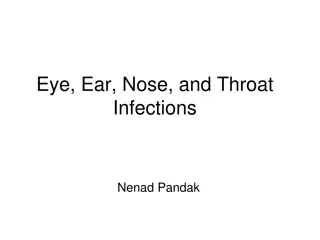Overview of Pharyngitis: Symptoms, Causes, and Classification
Pharyngitis is characterized by sore throat, categorized as acute or chronic. Acute pharyngitis has a sudden onset, while chronic pharyngitis persists longer. Chronic types include hypertrophic, atrophic, and granular, each with specific characteristics. Majority of cases are viral, with streptococcus being a common bacterial cause. Other causes include chemical and thermal irritations, neoplasms, allergies, and reflux disease.
Download Presentation

Please find below an Image/Link to download the presentation.
The content on the website is provided AS IS for your information and personal use only. It may not be sold, licensed, or shared on other websites without obtaining consent from the author. Download presentation by click this link. If you encounter any issues during the download, it is possible that the publisher has removed the file from their server.
E N D
Presentation Transcript
Definition pharyngeal wall characterized by pain over pharynx (sore throat) Definition inflammation of the pharynx or Classification Acute and chronic pharyngits Classification
Acute It is of sudden onset Short duration It may be purulent or ulcerative Acute pharyngitis pharyngitis Chronic Gradual onset Long duration of symptoms Due to persistent inflammation of the pharynx Chronic pharyngitis pharyngitis
Chronic Hypertrophic characterized by general thickening and congestion of the pharyngeal mucous membrane Atrophic the membrane is thin, whitish, glistening Granular characterized by numerous swollen lymph follicles on the pharyngeal wall Chronic pharyngitis pharyngitis are of 3 types are of 3 types Hypertrophic Atrophic Granular If tonsillitis involves it is termed as pharyngotonsillitis pharyngotonsillitis
Majority of cases are due to an infectious organism acquired from contact with an infected individual Infectious causes Viral (40 Adenovirus lymph node enlargement will be there and severe throat pain Influenza rapid onset of high temperature, headache and sore throat Epstein barr virus (mononucleosis) marked redness and swelling and exudative tonsillitis Herpes simplex virus mouth ulcers Measles ,Rhinovirus, coronavirus, RSV and HIV. Infectious causes Viral (40- -80%) 80%)
GROUP A streptococcus (GAS) Streptococcus pneumoniae Haemophilus influenzae Bordetella pertusis Cornybacterium diphtheriae Arcanobacterium haemolyticum
Group A beta hemolytic streptococcus (GAS) Most common bacterial cause. Fever, sore throat and large lymph nodes are the symptoms Contagious - infection spread by close contact Fungal causes Candida albicans oral thrush Fungal causes
Chemical irritation smoking Thermal irritation Head and neck neoplasm Allergies , allergic rhinitis Gastroesophageal reflux disease
Sore throat, dry or scratchy throat Sneezing Runny nose Headache Fatigue Body aches Chills Fever
Strep throat can cause Trouble swallowing Red throat with white patches Swollen lymph nodes Fever Chills Loss of appetite and nausea Unusual taste in mouth General malaise Strep throat can cause
History collections Physical examination Throat swab culture Blood tests CBC RSAT rapid streptococcal antigen test
Symptomatic treatment Analgesics acetaminophen and NSAIDS Steroids (dexamethasone) acetaminophen relieves pain Antibiotics for bacterial infection Antiviral for viral infection Antifungal imidazole, triazole, thiazole
Ear infection Sinusitis Abscess near the tonsils Rheumatic fever if strep throat is not treated Glomerulonephritis Scarlet fever
Drinking plenty of fluids Lemon tea or tea with honey Fluid food rather than solid Gargling with warm salt water Using throat lozenges Using humidifier Proper rest Acetaminophen if needed to decrease pain
Avoid sharing food, drinks and eating utensils Hand washing after coughing or sneezing Use alcohol based hand sanitizers Avoid smoking























